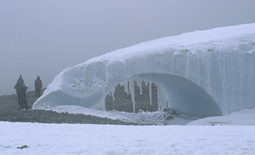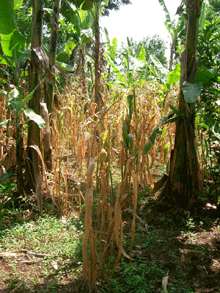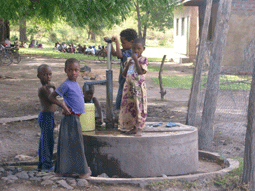Early Signs: Kilimanjaro
Air Date: Week of May 19, 2006

The view of Kibo, Mt. Kilimanjaro's last remaining glaciated peak, from 11,300 feet. Scientists expect the glaciers on Kibo will disappear in the next 10-15 years following a worldwide trend of glacial retreat due to global warming. (Photo: Kate Cheney Davidson)
You may have heard the snows of Kilimanjaro are fast disappearing. It turns out, so are the forests. Reporter Kate Davidson spent time with scientists and local farmers in Tanzania to look at the combined effect of tree-cutting and climate change in this installment of the series Early Signs: Reports from a Warming Planet.
Transcript
CURWOOD: Today we have another installment of our special series, Early Signs: Reports from a Warming Planet. The series is a collaboration of the UC-Berkeley Graduate School of Journalism, Salon dot com, and Living on Earth to document places around the world where concerns about climate change are already having an impact.
Places like 20,000 feet above a dry, grassy savanna in northern Tanzania where Africa’s tallest mountain rises. But the snows of Mount Kilimanjaro made popular by author Ernest Hemingway are rapidly disappearing. Following a worldwide trend of glacial retreat due to global warming, scientists say that Kilimanjaro’s ice fields are expected to vanish completely in the next 10 to 15 years.
But it’s not only the glaciers that are under stress. The way of life for people downstream, who rely on the mountain’s melt and forests, is also at risk. Reporter Kate Cheney Davidson has our story.
[SOUND OF CAR DRIVING ON A DIRT ROAD]
DAVIDSON: It’s mid-morning and the equatorial heat is already seeping into our green Land Cruiser as it bounces along a rutted dirt road.
THOMPSON: I first came here in 1999, so this will be my third trip.
DAVIDSON: Professor Lonnie Thompson is one of the world’s leading experts on tropical glaciers. He watches out his window as we speed past flat-topped acacia trees and fields of sunflowers.
THOMPSON: The tropics, to me, are an extremely important area to understand for two basic reasons. One is that you have 50 percent of the surface area of the planet in the tropics. And two, you have 70 percent of the 6.5 billion people living there.
DAVIDSON: Professor Thompson says it added to his sense of urgency when, six years ago, he compared fresh photos of the mountain with maps drawn ninety years earlier. The results shocked him.
THOMPSON: And it turned out that 82 percent of the ice had disappeared. And if you look at just the projection of the rate of loss, sometime before 2020 the ice fields on this mountain will be gone.

The view of Kibo, Mt. Kilimanjaro's last remaining glaciated peak, from 11,300 feet. Scientists expect the glaciers on Kibo will disappear in the next 10-15 years following a worldwide trend of glacial retreat due to global warming. (Photo: Kate Cheney Davidson)
Ice is very much a threshold system. If the temperature is minus 1 degree Celsius, it’s perfectly happy, but once you reach zero and it starts to melt, the ice will disappear much more rapidly. And there’s evidence since 2000 that there’s actually been lakes that have burst out the sides of the glaciers, so melting has taken place.
Three years ago a glacial wall suddenly collapsed, spewing geysers of water and room-size blocks of ice onto a trail. No one was hurt, but this year three Americans died as a result of a freak rock fall high up on the mountain. These events, says Professor Thompson, could be further signs that the mountain is responding to a historic shift in climate. And that, he says, could be a harbinger of much larger human costs – not for recreationists, but for farmers.
THOMPSON: The ultimate question here is what’s the impact of the loss of ice fields 15 years from now on water supplies for the people who live at the base of the mountain?
[BIRD CALLS]
DAVIDSON: Meet William Kiwali, chairman of the small village of Kifura.
[FAINT SOUND OF BIRDS AND INSECTS]
KIWALI [VOICEOVER]: I’m a farmer. I grow coffee, corn, and bananas.
DAVIDSON: Here on a sun baked farm a half-mile below Kilimanjaro National Park, the evidence of a changing climate is obvious.
[SOUNDS OF WALKING IN A DRY CORNFIELD]
DAVIDSON: Mr. Kiwali leads us into a field of parched cornstalks that lean like drunkards at a bar. His farm, like many others on the slopes of Kilimanjaro, is not doing well.
KIWALI [VOICEOVER]: My farm is dry now, and so are the other farms, because there is not enough water.
DAVIDSON: Normally this region of East Africa receives two periods of precipitation, but the short rains, which were due in September, haven’t come for the past three years. Mr. Kiwali’s farm is one of hundreds that blanket this area, located in Mt. Kilimanjaro’s rain shadow. And despite occasional droughts, there’s usually plenty of water here. But Mr. Kiwali says this is not the land he remembers as a child.

An ice arch on the summit of Mt. Kilimanjaro. This photo was taken in 2001, and its position documented using a global positioning system (GPS) device (Photo: Douglas Hardy, University of Massachusetts Geosciences)
DAVIDSON: For generations, people here have relied on a clever system of furrow irrigation. It can send water to farms miles away from any source. But now local villagers say the rivers and streams that feed the irrigation ditches are starting to go dry.
[SOUNDS OF RUNNING WATER]
DAVIDSON: Wearing high rubber boots in the mud, Mr. Kiwali points to a ditch containing a small trickle of water. He says he is surprised to even be standing here.
KIWALI [VOICEOVER]: In the 70s, this place was filled with water and you couldn’t cross here. But now, a lot of ditches are dried out and the rivers are low. And even the rivers that have water only have a little.

What remains of the arch, January 2006. (Photo: Douglas Hardy, University of Massachusetts Geosciences)
KIWALI [VOICEOVER]: No, there’s not enough water for people, so they start quarreling. Sometimes they cut each other with machetes. It’s not normal. In the past there was no such thing.
[MOTOR STARTS]
DAVIDSON: We load into Professor Andreas Hemp’s battered four-wheel drive and climb another 2,600 feet into the forest. This is the place some scientists and government officials worry most about. The glaciers may grab headlines, but the forests are also in danger from a changing climate.
HEMP: We are now going on the main road up into the forest. You see a lot of bananas here, the main crop.
DAVIDSON: Andreas Hemp is an energetic German ecologist who has been studying the forests on Kilimanjaro for 10 years. Over the past seven decades, he says, people have cut down huge swaths of trees, and even more have been lost to fire. But Professor Hemp believes it’s all exacerbated by climate change. Over the last 100 years, there’s been a steady decline in precipitation. And if the forests are destroyed, he says, the mountain and the people who live on it will lose the majority of their water.
HEMP: Now we come nearer to the end of the banana-coffee belt. And we are soon entering the forest reserve.
[SOUND OF CAR TURNING OFF, CAR DOOR SLAMMING SHUT, SOUNDS OF WALKING INTO THE FOREST]
DAVIDSON: The upper forests on Mt. Kilimanjaro perform an almost magical function. In a process called “fog-stripping,” large leafy trees on the upper mountain collect water vapor and funnel it in the form of droplets down to the forest floor. This process is believed to produce enough water annually for the entire population of Kilimanjaro.
We’ve come to the forest to check on one of the rain gauges that Professor Hemp has placed all over the mountain. Over the years, he has recorded Kilimanjaro’s loss of rain and fog water. If current conditions persist, he warns…
HEMP: Then we will lose the upper forest regions during the same time during which we lose the glaciers. It’s a parallel trend.
[SOUND OF VEGETATION BEING PULLED]
DAVIDSON: We stop at a huge tree fern. Professor Hemp pulls branches away to reveal a five gallon plastic bucket tucked against its base.
HEMP: This is a very simple system. You have a funnel on top, this collects the water, the rainfall…
DAVIDSON: Though it’s hard to imagine, Hemp says the water collected annually here in the forest is five hundred times the amount released by the glaciers.
HEMP: You can estimate the annual loss of the glaciers and the annual output of the melting water. Our estimations of the water output of water from the forest belt, and we can compare them. Five hundred million tons per year from the forest and one million tons from the glaciers.
DAVIDSON: Back at Professor Hemp’s laboratory we sit surrounded by satellite maps and rich botanical illustrations of the forest. He grimaces when asked to contemplate the future of the mountain and its water.
HEMP: If it’s going on like this, then it really would be a catastrophe. Because if we lose the forest cover due to illegal logging, due to fires, then we lose our permanent outflow of water on the mountain. A population of over one million people live on the mountain depends highly on a permanent, constant water output of the mountain. This would not be the case if we lose the forest cover.
DAVIDSON: The Tanzanian government is now trying to protect these endangered forests. President Jakaya Kikwete recently banned all tree cutting in Kilimanjaro’s preserves. And Tanzanian water officials and several civic and conservation groups have been helping people prepare for the dry times to come.
WEST: My name is Kelly West and I work for IUCN, the World Conservation Organization based in Eastern Africa.
DAVIDSON: Kelly West’s organization is helping fund the new initiative, called the Pangani River Basin Management Project.
WEST: One of our big messages in this project is we’re not just in a period of a few bad years. Climate change predictions for this area are strong. There’s likely to be a strong negative climate change impact in terms of river flows. So we wanted to work with both water managers and water users to look at the way they use water, and how we are going to plan ourselves for reduced flows.
DAVIDSON: Over three million people depend on the Pangani River, which drains Mt. Kilimanjaro, for their crops and livestock. But the challenge, says Ms. West, is to convince farmers that water is more than a gift from God.
WEST: For a long time…people are still in the mentality that we’re just having a bad year, but you’re not going to have the rains that you remember from your childhood again. Climate change is happening and people need to change the way they use water.
[SOUND OF INSECTS HUMMING AND CHILDREN PLAYING]
DAVIDSON: There’s one region where the future is already here. As you might expect, it’s downstream. The people of Mwangaria, a village on the dry, dusty savanna below Mt. Kilimanjaro, are losing their traditional sources of water because it’s getting used up before it reaches them. Now they must rely solely on the rains to water their crops, which makes them very vulnerable to any drought or change in rainfall.
[WALKING AND INSECT SOUNDS]
DAVIDSON: We meet Rispaeli Jonas hiding from the blistering afternoon sun with a group of older women beneath a stand of trees. Her hair is plaited in straight cornrows and she wears a multi-colored kanga, a traditional African wrap skirt.
JONAS [VOICEOVER]: Right now we ask ourselves in Mwangaria what is happening? Is it because we cut a lot of trees? We are truly astonished because it’s been three years now and we still don’t have enough food to eat.
DAVIDSON: And when she’s hungry, she admits she does something that will only make her situation worse.
JONAS [VOICEOVER]: So when the drought comes and there is no rain, we cut trees for money to buy food at the market.
DAVIDSON: In this part of Africa, as in some other places that fortune has skipped over, climate change is likely to aggravate what humans have already done to the landscape.
SAGURO [VOICEOVER]: My name is Israeli Saguro. My family name is Mmanyi, and I’m 52 years old.
DAVIDSON: There will probably be more people like Mr. Saguro, whose job it is to supervise the water supply for Mwangaria, a place that has no water. That’s because a government-endorsed rice-growing scheme diverted the village’s main water source more than a decade ago. And now, there’s drought.

Parched corn leans listlessly on a farm near the village of Kifuru, located at about 5,000 feet on Mt. Kilimanjaro's south side. Local farmers say corn harvests have suffered for the past three years due to lack of rain. (Photo: Jon Lewis)
When there wasn’t drought, I lived a happy life. I wasn’t suffering like I am now. I had plenty of food and water, and the weather was good. Now it’s extremely hot and there is no day when the weather is good.
[SOUNDS OF INSECTS.]
DAVIDSON: Mr. Saguro gets up from the couch in his modest house made of narrow logs chinked with mud. Gently, he lifts a small wooden instrument from a peg on the wall. It’s called an irimba, and his father showed him how to make it.
[STRUMMING OF IRIMBA]
Mr. Saguro tells us he knows exactly what song he wants to play.

Children gather around the only water pump left in Mwangaria; the other pump ran dry in the early 1990s. Villagers say this is the only safe drinking water they have. (Photo: Jori Lewis)
DAVIDSON: The song says people are dying and asks, who is willing to climb aboard the Lord’s ship to help?
[IRIMBA PLAYING AND SINGING]
For Living on Earth, I’m Kate Cheney Davidson in Mwangaria, Tanzania.
CURWOOD: Our story on Mount Kilimanjaro was produced with help from Elizabeth Chur. “Early Signs” is a collaboration of the UC-Berkeley Graduate School of Journalism, Salon dot com, and Living on Earth. To read a print version of the story about Mount Kilimanjaro and see photos - visit our website Living on Earth dot org. That’s Living on Earth dot O-R-G.
 |
 |  |  |
Links
To see a print version of this story, and other reports in this series, click here
Living on Earth wants to hear from you!
Living on Earth
62 Calef Highway, Suite 212
Lee, NH 03861
Telephone: 617-287-4121
E-mail: comments@loe.org
Newsletter [Click here]
Donate to Living on Earth!
Living on Earth is an independent media program and relies entirely on contributions from listeners and institutions supporting public service. Please donate now to preserve an independent environmental voice.
NewsletterLiving on Earth offers a weekly delivery of the show's rundown to your mailbox. Sign up for our newsletter today!
 Sailors For The Sea: Be the change you want to sea.
Sailors For The Sea: Be the change you want to sea.
 The Grantham Foundation for the Protection of the Environment: Committed to protecting and improving the health of the global environment.
The Grantham Foundation for the Protection of the Environment: Committed to protecting and improving the health of the global environment.
 Contribute to Living on Earth and receive, as our gift to you, an archival print of one of Mark Seth Lender's extraordinary wildlife photographs. Follow the link to see Mark's current collection of photographs.
Contribute to Living on Earth and receive, as our gift to you, an archival print of one of Mark Seth Lender's extraordinary wildlife photographs. Follow the link to see Mark's current collection of photographs.
 Buy a signed copy of Mark Seth Lender's book Smeagull the Seagull & support Living on Earth
Buy a signed copy of Mark Seth Lender's book Smeagull the Seagull & support Living on Earth

